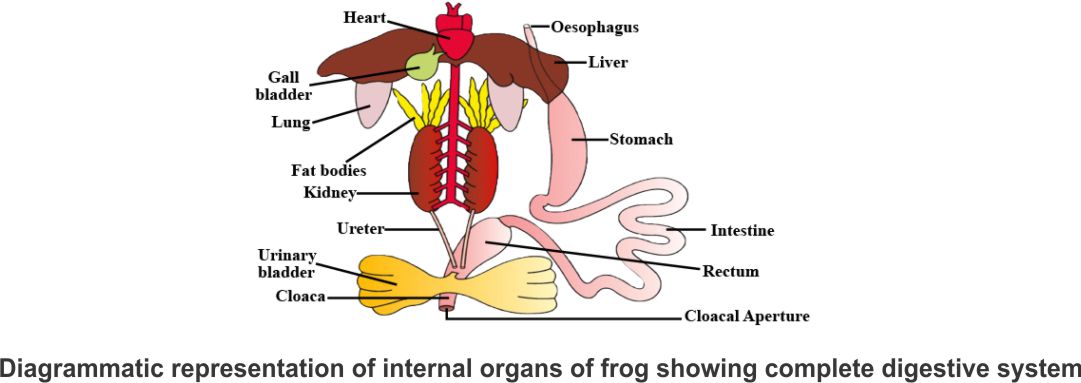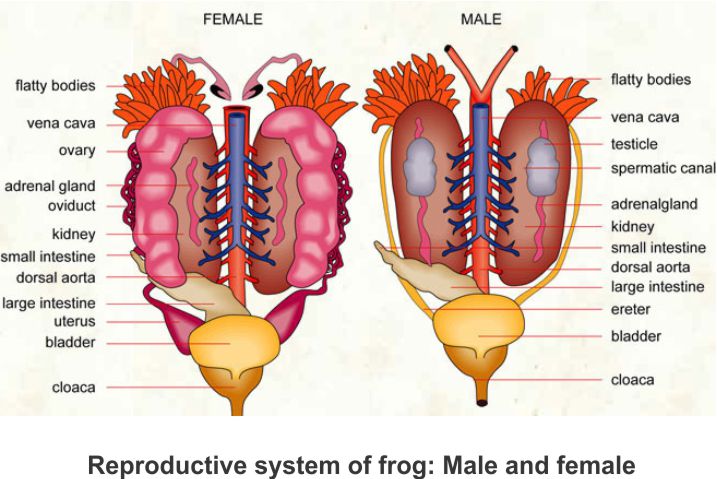Anatomy of Frog
The anatomy of a frog encompasses various organ systems:
1. Body Structure:
- Frogs have a head and trunk, lacking a neck and tail.
- The body skin is smooth and slimy due to mucus, kept moist to facilitate respiration.
- Dorsal skin is typically olive green with dark spots, while the ventral side is pale yellow.
- Frogs maintain moisture balance through skin absorption.
- Sexual dimorphism is present, with males having vocal sacs and copulatory pads on the first digit of the forelimbs.
- Frogs are carnivores, so their alimentary canal is short.
- The mouth leads to the buccal cavity, then the oesophagus, stomach, intestine, and rectum.
- The liver secretes bile stored in the gall bladder.
- The pancreas produces pancreatic juice.
- Food digestion occurs through HCl and gastric juices in the stomach.
- Chyme, partially digested food, moves to the duodenum, where it receives bile from the gall bladder and pancreatic juices.
- Bile emulsifies fat, while pancreatic juices digest carbohydrates and proteins.
- The final digestion takes place in the intestine, where absorption occurs through villi and microvilli.
- Undigested waste exits through the cloaca.

3. Respiratory System:
- Frogs respire in both water and on land.
- The skin serves as an aquatic respiratory organ through cutaneous respiration.
- On land, frogs use buccal cavity, skin, and lungs for pulmonary respiration.
- The lungs are elongated, sac-like structures in the thorax.
- During aestivation and hibernation, skin facilitates gaseous exchange.
- Frogs have a closed circulatory system with a well-developed heart.
- The heart has three chambers (two atria and one ventricle) and is covered by the pericardium.
- Blood is carried by arteries to various body parts and returned to the heart via veins.
- Special venous connections exist between the liver and intestine and the kidney and lower body parts.
- The blood consists of plasma, RBCs (nucleated with haemoglobin), WBCs, and platelets.
- Frogs also have a lymphatic system.
- The excretory system includes kidneys, ureters, cloaca, and urinary bladder.
- Two ureters emerge from the kidneys in males (females have separate openings for oviducts and ureters).
- Frogs are ureotelic, excreting urea.
- Excretory wastes are carried by the blood to the kidneys, separated, and excreted.
- Frogs possess both a neural system and endocrine glands.
- The brain is divided into forebrain, midbrain, and hindbrain.
- The central nervous system includes the brain and spinal cord, with peripheral and autonomic nervous systems.
- Frogs have well-developed sense organs for touch, taste, smell, vision, and hearing.
- Males have paired testes and vasa efferentia that open into the urinogenital duct.
- The female reproductive system includes paired ovaries and separate oviducts.
- Fertilization is external in water, with development involving a tadpole stage that undergoes metamorphosis into an adult frog.
